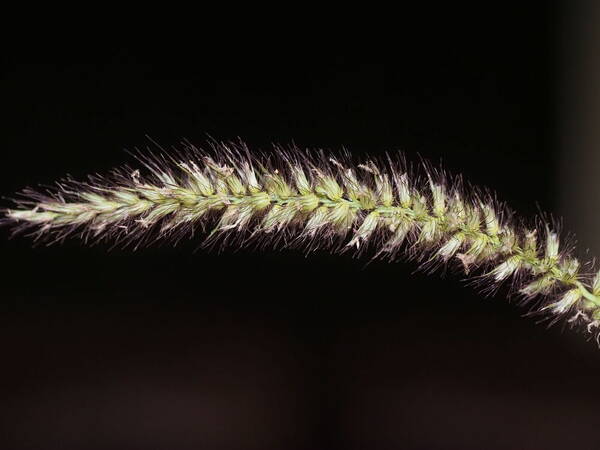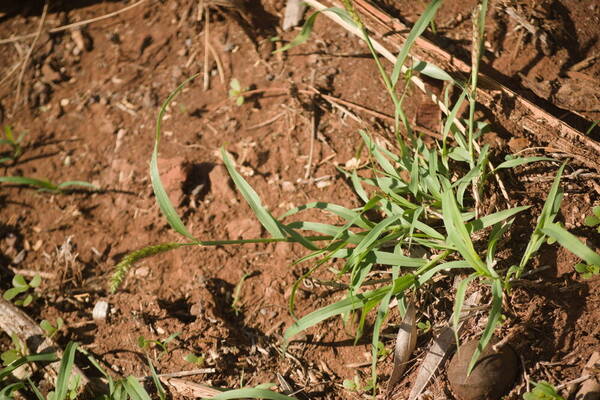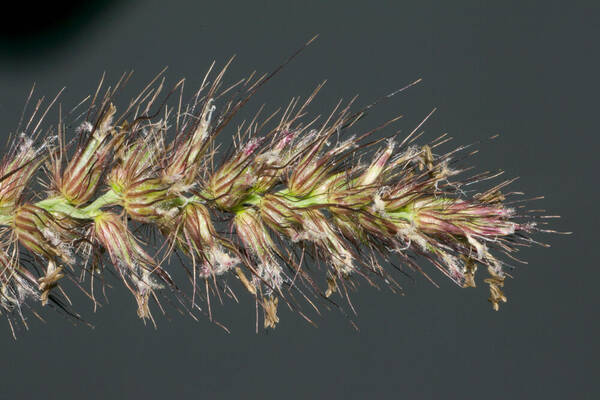Info
Subfamily: Panicoideae
Genus etymology: Cenchrus = "millet" [Greek]. However this is a misnomer, the only millet species in this genus is C. americanus, and this was treated as Pennisetum when Cenchrus was erected.
Species etymology: ciliaris = "ciliate" [Latin] refering to the hairs of the involvucre
Photosynthetic type: C4 (warm season)
Nativity: naturalized - intentional
First recorded in Hawaiʻi: 1932
Map


Inflorescence



Plant


Habit








Spikelets







Landscape


Collar



Rhizomatous cultivar









Description
Perennial, often forming mats or tussocks; culms 10–150 cm., ascending, wiry or sometimes almost woody. Leaf-blades 3–25 cm. long, 2–13 mm. wide. Panicle cylindrical to ovoid, 2–14 cm. long, 10–26 mm. wide, grey, purple or straw-coloured, the rhachis angular and puberulous; involucre elongate, 6–16 mm. long; inner bristles much exceeding the spikelets, one of them longer and stouter than the rest, at least the longest somewhat flattened at the base, connate only at the base to form a disc 0.5–1.5 mm. in diameter (or sometimes connate for up to 0.5 mm. above the disc’s rim), sparsely or densely ciliate below, grooved on the face or not, filiform above, flexuous, often wavy, antrorsely scaberulous; outer bristles filiform. Spikelets 1–4 per burr, 2–5.5 mm. long, acutely lanceolate; glumes distinct, acute, the lower from 1/4–1/2, the upper from 1/2 to as long as the spikelet.
(Description source: Clayton, W.D. & Renvoize, S.A. 1982. Flora of Tropical East Africa. Gramineae (Part 3). A.A. Balkema, Rotterdam. 448 pp. )
Perennial, often forming mats or tussocks; stems up to 150 cm high, wiry or somewhat woody; leaves flat, 2–13 mm wide. Panicle 2–14 cm long; involucre elongate, 6–16 mm long; inner bristles much exceeding the spikelets, one of them longer and stouter than the rest, united only at the base to form a disc 0.5–1.5 mm in diam. (or sometimes connate for up to 0.5 mm above its rim), sparsely to densely ciliate below, filiform above, flexuous, antrorsely scaberulous; outer bristles filiform. Spikelets 1–4 per burr, 2–5.5 mm long.
(Description source: Cope, T.A, (1995) Flora Somalia, Vol 4. Royal Botanical Gardens, Kew, London. 312 pp. )
Perennial, often forming mats or tussocks. Culms 10–150 cm. high, ascending, wiry or sometimes almost woody. Panicle 2–14 cm. long, cylindrical to ovoid, grey, purple or straw-coloured; involucre 6–16 mm. long, connate only at the base to form a disk 0.5–1.5 mm. in diam.; inner bristles flexuous, often wavy, sparsely to densely ciliate below, filiform above, one of them longer and stouter than the rest, this at least somewhat flattened towards the base; outer bristles filiform. Spikelets 1–4 per bur, 2–5.5 mm. long, acutely lanceolate. Glumes distinct, acute, the inferior from 1/4–1/2, the superior from 1/2 to as long as spikelet. Superior lemma chartaceous.
(Description source: Launert, E. & Pope, G.V. (eds.). 1989. Flora Zambesiaca. Volume 10. Part 3. Kew, London. 152 pp. )
Plants perennial; cespitose from a hard, knotty base, with or without rhizomes. Culms 10-150 cm, erect, sometimes branching at the aerial nodes, glabrous, sometimes scabrous beneath the panicle; nodes glabrous. Leaves green or glaucous; sheaths glabrous or pubescent, margins ciliate; ligules 0.5-3 mm, membranous, ciliate; blades 3-50 cm long, 2-13 mm wide, flat, glabrous or pubescent, margins ciliate or glabrous basally. Panicles 2-20 cm long, 4-35 mm wide, fully exerted from the sheaths, erect, green, brown, brown-purple, or dark purple; rachises terete, scabrous. Fascicles 11-37 per cm, disarticulating at maturity; fascicle axes 0.2-1.5 cm, with 1-12 spikelets; outer bristles 16-89, 0.3-11.7 mm, many exceeding the spikelets; inner bristles 7-20, 3.8-13.8 mm, fused to 1/4 of their length, flattened, grooved, ciliate; primary bristles 10.5-23 mm, long-ciliate, noticeably longer than the other bristles. Spikelets 2.5-5.6 mm, sessile, glabrous; lower glumes 1-3 mm, 0-1-veined; upper glumes 1.3-3.4 mm, about 1/2 as long as the spikelet, (0)1-3-veined; lower florets staminate or sterile; lower lemmas 2.5-5.3 mm, 3-7-veined; lower paleas absent or 2.5-5 mm; anthers absent or about 1.4 mm; upper florets not disarticulating at maturity; upper lemmas 2.2-5.4 mm, (3)5(6)-veined, margins glabrous; anthers 1.4-2.7 mm. Caryopses 1.2-1.9 mm long, 0.4-1 mm wide, concealed by the lemma and palea at maturity. 2n = 36, 45.
(Description source: Barkworth, M.E., Capels, K.M., Long, S. & Piep, M.B. (eds.) 2003. Flora of North America, north of Mexico. Volume 25. Magnoliophyta: Commelinidae (in part): Poaceae, Part 2. Oxford University Press, New York. 783 pp http://floranorthamerica.org/Cenchrus_ciliaris )
Perennials, sometimes short-rhizomatous and forming mats or tussocks; culms ascending, 10-150 cm tall, 1-2 mm in diameter, wiry or sometimes almost woody at base, sometimes many-branched from lower or basal nodes. Sheaths keeled, glabrous or sparsely pilose; ligule a densely ciliate membrane 0.5-2.5 mm long; blades 3-25 cm long, 2-13 mm wide, glabrous or sparsely pilose, apex caudate. Inflorescences paniculate, gray, purple, or yellowish, densely cylindrical to ovoid, 2-14 cm long, 1-2.6 cm wide, rachis angular and puberulent; burs 6-16 mm long, bristles connate only at base to form a disk 0.5-1.5 mm in diameter, inner bristles much exceeding spikelets, 1 of them longer and stouter than the rest, at least the longest somewhat flattened at base, sparsely or densely ciliate below, grooved on the face or not, filiform above, flexuous, often wavy, antrorsely scaberulous, outer bristles filiform; spikelets 1-4 per bur, 2-5.5 mm long, dorsally compressed, lanceoloid; glumes distinct, first glume membranous, I-nerved, 1-3 mm long, second glume 1-3-nerved, 1.3-3.5 mm long; first lemma 5-6-nerved, 2.5-5 mm long; palea 2.5-5 mm long, enclosing a staminate flower; second lemma thin, 5- nerved, 2.2-5.4 mm long. Caryopsis turgid, ovoid, 1.4-1.9 mm long, ca. 1 mm in diameter. [21 = 32, 34, 35, 36, 40, 43-45, 48, 52, 54, 56.]
(Description source: O’Connor, P.J. 1990. Poaceae, pp. 1481–1604. In: Wagner W.L., Herbst D.R. & Sohmer S.H. (eds.)., Manual of the flowering plant of Hawaiʻi. Vol. 2. University of Hawaii Press & Bishop Museum Press, Honolulu )